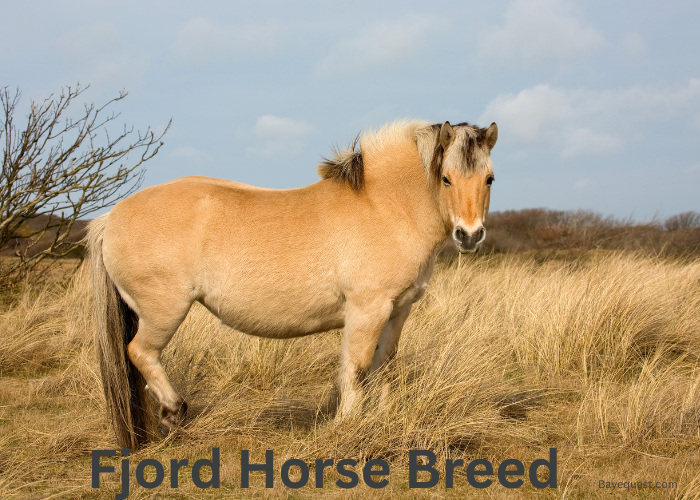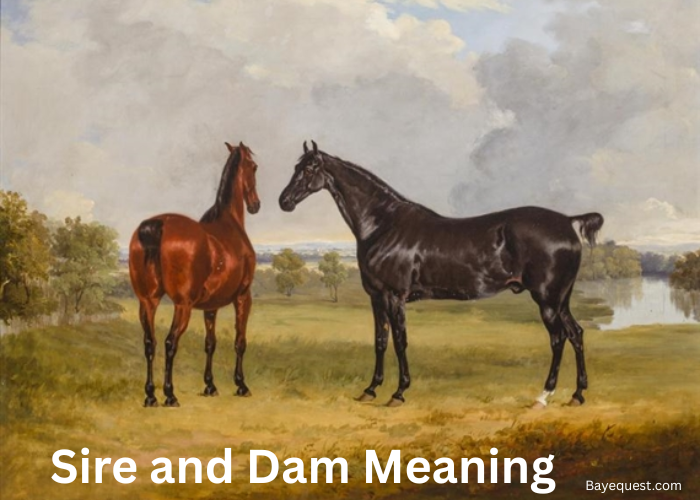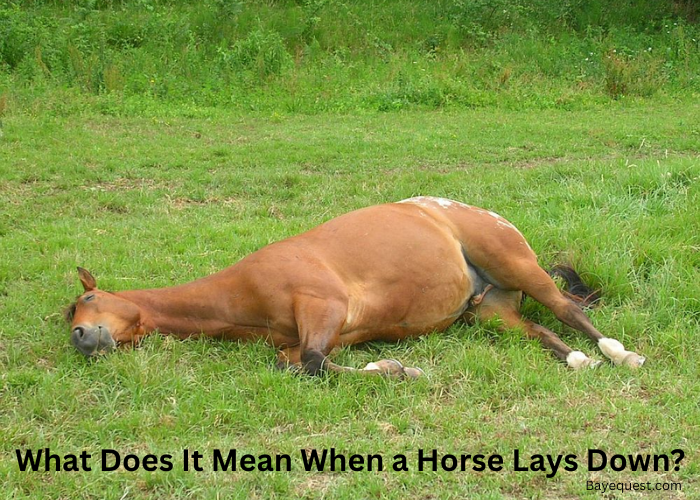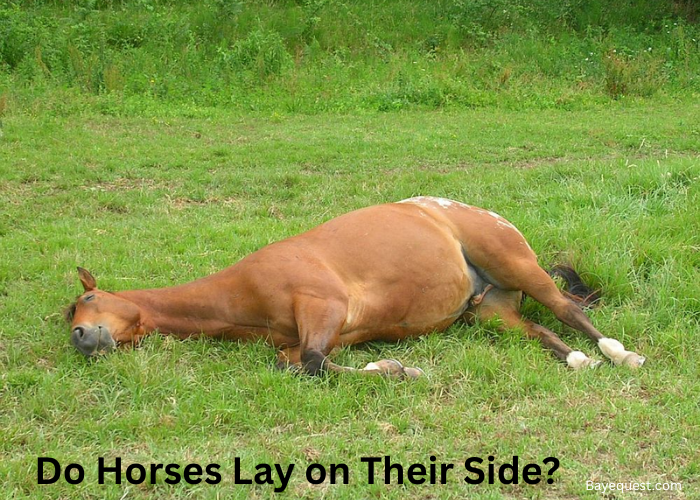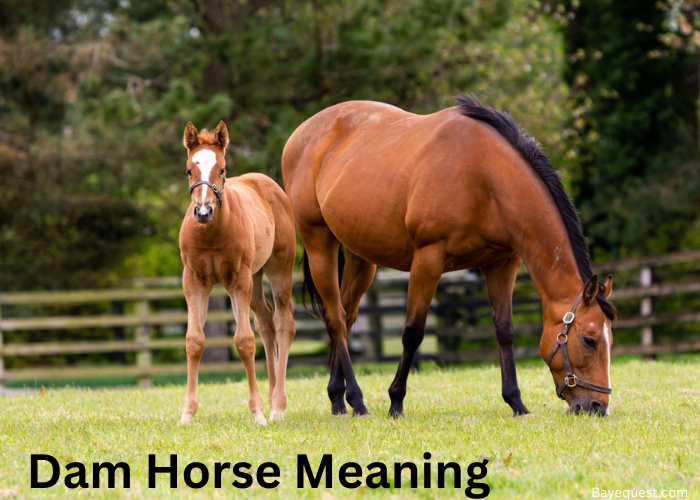The Fjord horse is a special kind of horse. It has a cool two-toned mane and a history that dates back to the Vikings.
Fjords are small but strong. They’ve been used for farming, pulling carts, and winning hearts for hundreds of years.
They’re calm, easy to handle, and hard to forget.
If you love horses or just want to learn something new, this Norwegian breed is worth your time.
Let’s take a closer look at what makes the Fjord horse so loved around the world.
Fjord Horse Breed Profile: Key Takeaway
| Category | Description |
| Temperament | Calm, gentle, and friendly; perfect for riders of all ages. |
| Intelligence | Quick learners and highly trainable, making them versatile in many activities. |
| Strength | Compact and muscular, capable of handling heavy work and carrying adult riders. |
| Size | Typically 13.2 to 14.2 hands high; manageable for children and adults alike. |
| Weight | Average weight ranges between 900 to 1,200 pounds, reflecting their sturdy build. |
| Coat Colors | Unique dun shades (brown, red, gray, yellow, and white) with a dark dorsal stripe. |
| Mane | Thick and two-toned; traditionally trimmed for a standing, iconic look. |
| Adaptability | Hardy and resilient, thriving in various climates and terrains. |
| Uses | Suitable for driving, riding, farm work, therapy, and equestrian sports. |
| Longevity | Average lifespan of 25–30 years with proper care. |
| Maintenance | Low-maintenance breed with natural hardiness and strong hooves. |
History and Origin of the Fjord Horse Breed
The Fjord horse has a history as old as time. It originated in Norway over 4,000 years ago.
This breed is one of the oldest and purest in the world. Archaeological findings suggest Fjord horses were domesticated by the early Norse people.
They played a big role in the Viking era, serving as war horses and work companions.
The Vikings prized them for their strength, agility, and loyalty.
Fjord horses were used for farming, transportation, and even ceremonies. Their sure-footedness made them perfect for Norway’s rugged terrain.
Selective breeding began centuries ago to preserve their unique traits.
The goal was to maintain their sturdy build, calm temperament, and iconic dun-colored coat.
Five shades of dun are now recognized, a feature unique to this breed.
Over time, the Fjord horse became a symbol of Norwegian heritage. It has also gained popularity worldwide for its versatility and charm.
From ancient warriors to modern equestrians, the Fjord horse has remained a trusted companion.
Its rich history and enduring qualities make it a living piece of history. Today, Fjords continue to excel in work, sports, and as beloved family horses.
Personality and Character of the Fjord Horse Breed
The Fjord horse has a gentle and friendly personality. They are calm, dependable, and incredibly versatile.
These traits make them perfect for riders of all ages and skill levels. They are also highly intelligent and quick to learn, which makes training them a breeze.
They have a strong work ethic and a willing attitude.
Whether it’s pulling a plow, participating in equestrian sports, or being a therapy horse, they give their best effort.
Their calm temperament also makes them great around children and in busy environments.
Fjords are social and form strong bonds with their handlers. They are also patient and steady, making them ideal for first-time horse owners.
Despite their calm demeanor, Fjords can also be spirited and playful. They enjoy engaging in activities and thrive on attention.
This breed is as dependable as they come. Fjords rarely spook, even in challenging situations.
Their combination of strength, intelligence, and affection makes them a true joy to be around.
Fjord Horse Breed Conformation
The Fjord horse is compact, strong, and built to endure. Its conformation reflects its roots in Norway’s rugged terrain.
Fjords have a muscular, sturdy body that supports both power and balance. They are versatile and resilient, and their physical traits make them ideal for various tasks.
Fjords stand between 13.2 and 14.2 hands high. Despite their smaller size, they are incredibly strong and can easily carry adult riders.
Their broad chest and deep barrel give them the power needed for heavy work.
The neck is muscular and arched, blending smoothly into a strong back and short, broad loins.
The head is medium-sized with a straight or slightly dished profile. Their large, expressive eyes and alert ears add to their intelligent appearance.
One of their standout features is their mane. It is thick, two-toned, and traditionally trimmed to accentuate the horse’s neckline.
Fjord horses have well-formed legs with clean joints and strong hooves. Their feet are naturally hard and rarely need shoes.
Overall, their conformation combines strength, balance, and grace, making them well-suited for work, riding, and driving.
Fjord Horse Breed Gait
The Fjord horse has smooth and natural gaits that make them comfortable to ride and versatile for various tasks.
They have three main gaits: walk, trot, and canter. These gaits are steady and balanced, reflecting the breed’s strong and compact build.
Their walk is relaxed and sure-footed, with even strides. It’s ideal for trail riding and working on uneven terrain.
The trot is smooth and efficient, with good rhythm and energy, making it perfect for driving and light riding.
The canter is collected and controlled, with a steady pace that feels secure for the rider.
Fjords are not known for flashy movement but for their reliability and ease of motion.
Their gaits are easy to sit, making them suitable for riders of all levels, from beginners to experienced equestrians.
This natural, steady movement has contributed to their reputation as dependable workhorses and versatile companions.
The Fjord Horse Breed Colors
The Fjord horse is famous for its distinct and stunning coat colors.
Every Fjord horse is a shade of dun, but there are five variations that make this breed truly unique.
These shades are earthy and natural, adding to the Fjord’s charm.
Brown Dun (Brunblakk). This is the most common color. It’s a warm, tan shade with darker points, including the dorsal stripe, mane, and tail.
Red Dun (Rødblakk). A lighter, reddish shade that stands out. It still features the signature dorsal stripe but with a softer hue.
Gray Dun (Grå). This color ranges from light silvery gray to darker tones. It has a striking contrast with the darker mane and tail.
Yellow Dun (Ulsblakk). A creamy, pale shade with lighter points. It’s less common but highly prized for its rarity.
White Dun (Kvit). Almost white with faint markings. This is the rarest of the Fjord colors.
Historic Use of the Fjord Horse Breed
The Fjord horse has a rich history of utility and versatility.
For centuries, it has been a trusted companion for various tasks, especially in Norway, where it originated.
Its strength, endurance, and calm temperament made it invaluable in both work and daily life.
In ancient times, Vikings used Fjord horses as war horses. Their sure-footedness and courage made them reliable in battle.
They carried warriors, supplies, and weapons through Norway’s challenging terrain.
As agriculture grew, the Fjord became a vital farmhand. Its muscular build and hard-working nature were perfect for plowing fields and hauling heavy loads.
Farmers relied on them for planting, harvesting, and forestry work.
Beyond work, Fjords played an essential role in transportation. They carried people and goods across rugged landscapes where other animals might struggle.
Their resilience in harsh weather conditions made them an ideal choice for remote areas.
Fjords were also used in ceremonies and cultural events, showcasing their beauty and grace.
Over the years, their versatility expanded into modern uses like riding and driving.
Today, they continue to honor their historic roots by excelling in both traditional and contemporary roles.
What is the Average Lifespan of the Fjord Horse Breed
The average lifespan of a Fjord horse is 25 to 30 years. Some can live even longer with good care. Fjords are strong and hardy.
They were bred to survive in tough conditions. This helps them live longer than many other breeds.
To keep a Fjord healthy, proper care is important. They need a balanced diet and clean water. Regular exercise keeps them fit.
Routine check-ups with a vet are also necessary. Good hoof and dental care are essential too.
Fjords rarely suffer from serious health problems. Their calm nature helps them avoid stress.
Many stay active and healthy as they age. With love and care, they can remain loyal companions for many years.
Read: What is the Average Lifespan of a Quarter Horse?
How to Care for a Fjord Horse
Caring for a Fjord horse is both rewarding and straightforward. These sturdy, lovable horses thrive with the right attention, and their needs aren’t overwhelming.
Here’s how you can keep your Fjord happy, healthy, and ready for adventure.
1. Feed them right
Fjord horses are easy keepers, but that doesn’t mean you should let them overindulge. Their diet should mainly include good-quality hay or fresh pasture.
They don’t need fancy grain mixes unless they’re working hard. Oh, and don’t forget – fresh, clean water is a must.
A salt block? That’s a nice bonus to keep their mineral levels balanced. Here are more reasons why horses need salt blocks.
2. Give them shelter
While Fjords are tough, they still need protection from extreme weather.
Whether it’s blazing sun, pouring rain, or biting cold, a clean stall or a run-in shed will keep them comfortable.
Let them roam and graze – they love the outdoors.
3. Keep them looking sharp
That iconic Fjord mane deserves some love! Brush their coat regularly and untangle their thick mane and tail.
Daily hoof cleaning is a must, too. A clean horse is a happy horse.
4. Exercise their body and mind
Fjords are built to work, so keep them moving. Riding, driving, or even some fun groundwork will keep them fit and engaged.
They’re quick learners and love a challenge, so mix things up to keep them entertained.
5. Stay on top of healthcare
Regular vet visits are key. Vaccinations, dental check-ups, and deworming should be on your schedule.
Keep an eye out for any unusual changes in behavior or appetite – Fjords are tough, but they’re not invincible.
6. Spend time with them
Fjords love attention and form strong bonds with their people. Groom them, talk to them, or simply hang out in their pasture.
Your time and care will mean the world to them.
Food and Nutrition Requirement of a Fjord Horse
Feeding a Fjord horse is all about balance. These horses are known as “easy keepers,” meaning they require less food than many other breeds.
Here’s how to meet their nutritional needs while keeping them healthy and happy.
1. Forage first
Fjord horses thrive on a diet primarily made up of forage. High-quality hay or fresh pasture should make up the majority of their meals.
This satisfies their natural grazing instincts and provides essential fiber for a healthy digestive system.
2. Limit grains
Because Fjords are prone to weight gain, they don’t usually need grain unless they’re doing heavy work or need extra energy.
If grain is necessary, choose a low-sugar and low-starch option to avoid health issues like laminitis.
3. Portion control
Overfeeding can lead to obesity, so it’s important to measure their portions. A Fjord horse needs 1.5–2% of their body weight in forage daily.
Adjust their intake based on their activity level and body condition.
4. Essential minerals
Provide a salt block or mineral lick to ensure they get important nutrients. A well-balanced vitamin and mineral supplement can also fill any gaps in their diet.
5. Freshwater
Always offer clean, fresh water. Fjords are active and will need plenty of hydration, especially in hot weather or after exercise.
6. Treats in moderation
Fjords love treats, but moderation is key. Carrots, apples, or commercially made horse treats are fine as an occasional reward.
Avoid sugary or high-calorie options that can contribute to weight gain.
Fjord Horse Discipline
The Fjord horse is a versatile breed that excels in various equestrian disciplines.
Here are the key disciplines where Fjords shine:
1. Driving
Fjord horses are natural-born drivers. Their powerful build and steady pace make them ideal for pulling carts, carriages, or wagons.
They perform exceptionally well in driving competitions, both in single and team setups.
2. Dressage
Don’t let their stocky build fool you – Fjords can be graceful in the dressage arena.
They are intelligent and eager to learn, making them excellent candidates for lower-level dressage.
Their calm demeanor helps them focus on precision and elegance.
3. Trail riding
With their sure-footedness and stamina, Fjords are perfect for trail riding. They handle rough terrain and steep trails with ease.
Their steady nature also makes them reliable companions for long-distance rides or exploring new areas.
4. Work and farming
Historically, Fjords were used for farming and forestry work. Today, they still excel in these traditional roles, pulling plows, logs, and other equipment.
Their strength and willingness make them ideal for heavy labor.
5. Therapeutic riding
Fjords are widely used in therapeutic riding programs. Their calm, gentle personality makes them safe and approachable for riders of all ages and abilities.
They are patient and reliable, creating a positive experience for everyone involved.
6. Equestrian sports
While not as common in high-level competition, Fjords can participate in jumping, eventing, and even vaulting.
Their versatility and enthusiasm allow them to try many different activities.
7. Family and leisure riding
Fjords are excellent family horses. Their gentle nature and manageable size make them great for children, beginners, and casual riders.
Whether it’s a fun ride around the paddock or a relaxed weekend outing, Fjords fit the role perfectly.
What is the Average Cost of a Fjord Horse?
The average cost of a Fjord horse is between $3,000 and $10,000. Some can cost more, especially if they have rare traits or special training.
Younger Fjords are usually cheaper than trained adults. Horses with good bloodlines or unique coat colors may also be more expensive.
Prices vary depending on location, with higher costs in areas where Fjords are rare.
Always consider extra expenses like transport, feed, and vet care. Buying a Fjord is a big investment, but their charm and versatility make it worth it.
Fjord Breed Specific Diseases
The Fjord horse is a hardy and resilient breed with few breed-specific diseases. However, like any horse, they can still face certain health issues.
Here are some conditions to watch for:
Obesity
Fjords are “easy keepers,” meaning they gain weight easily. Obesity can lead to other problems, like laminitis or metabolic issues.
Owners should monitor their diet and exercise to maintain a healthy weight.
Equine Metabolic Syndrome (EMS)
Due to their tendency to gain weight, Fjords are at risk of EMS.
This condition affects how their body processes sugar and can lead to insulin resistance and laminitis.
Proper feeding and regular exercise can help prevent this.
Laminitis
Laminitis is a painful inflammation of the hooves that can be triggered by obesity, EMS, or rich pasture.
Fjords are particularly prone to this if their diet isn’t managed carefully.
Sweet itch
Some Fjords may develop sweet itch, an allergic reaction to insect bites.
This causes intense itching, particularly along the mane, tail, and midline.
Preventive measures, like insect repellents and fly sheets, can help.
Parasite-related issues
Like all horses, Fjords are susceptible to internal parasites.
Regular deworming and pasture management are essential to prevent related health problems.
Is a Fjord Horse Suitable for Children?
Yes, a Fjord horse is highly suitable for children. Their calm and gentle temperament makes them ideal for young or inexperienced riders.
Fjords are patient and easy to please, which helps children feel safe and confident around them.
Another advantage is their manageable size. They are sturdy enough to carry older kids but small enough for young riders to handle.
Fjords are also steady and rarely spook, making them reliable companions in various situations.
Additionally, Fjords are intelligent and easy to train, allowing children to learn and bond with them quickly.
Norwegian Fjord Horse: FAQs
Does every Fjord horse have a standing mane?
Not naturally. While the Fjord horse has an iconic standing mane, this look is typically achieved through trimming. The mane grows naturally long and falls to the sides if left untrimmed. Owners trim it short to emphasize the dark center stripe, creating an upright appearance that highlights the horse’s strong neck.
What is the difference between a Norwegian and a Fjord horse?
There is no difference. The terms “Norwegian horse” and “Fjord horse” refer to the same breed. The Fjord horse originated in Norway and is deeply tied to its culture and history. While it may sometimes be called a Norwegian horse, “Fjord horse” is the official and widely recognized name for this breed.
What is a Fjod Horse? Conclusion
The Fjord horse is more than just a breed—it’s a treasure. From its rich history to its gentle nature, this horse has something special for everyone.
Its strength, versatility, and calm personality make it perfect for work, play, or simply as a companion.
Whether you’re a seasoned rider or new to horses, the Fjord will win your heart.
Their unique looks and loyal spirit set them apart from any other breed. Ready to meet your next best friend?
The Fjord horse is waiting to impress you.




